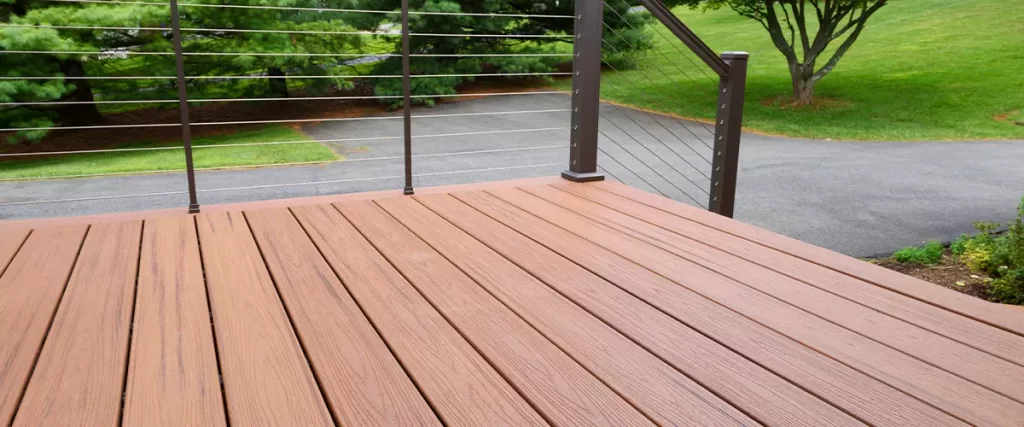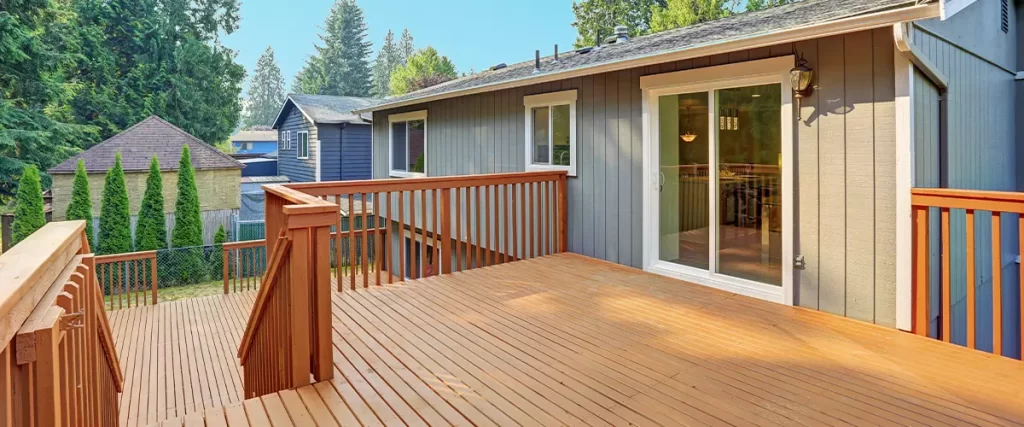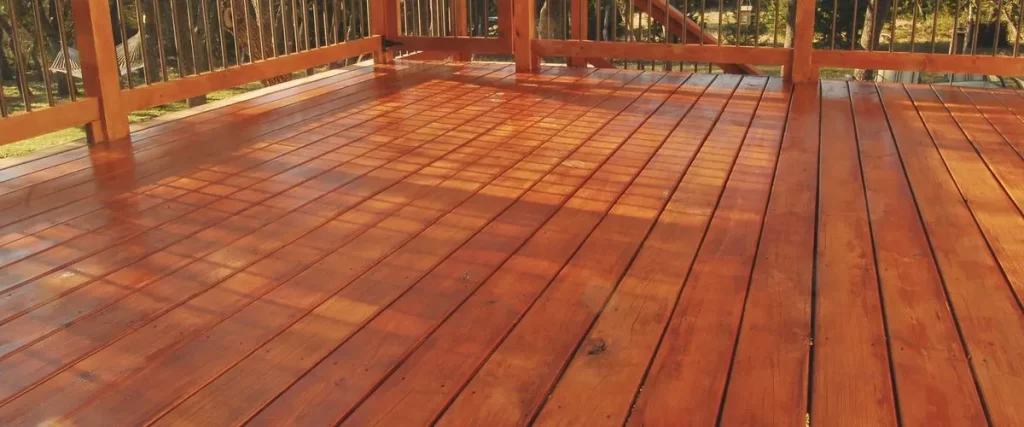Building a new deck is exciting. It’s one of those projects that changes how you live in your home, suddenly, your backyard becomes an extension of your living space. But one of the first decisions every homeowner faces is about materials. When it comes to PVC vs composite decking, the choice can feel overwhelming.
Both are strong contenders for durability, style, and longevity. Each has its own advantages and trade-offs depending on your priorities, looks, budget, maintenance, or environmental impact.
Let’s walk through what makes PVC decking and composite decking different, where they shine, and how to decide which one fits your home best.
PVC vs Composite Decking: Head-to-Head Comparison
Sometimes it helps to look at key differences side by side.
| Feature | Composite Decking | PVC Decking |
| Material Composition | Wood fibers + plastic | 100% plastic (polyvinyl chloride) |
| Appearance | Natural wood look | Smooth, modern finish |
| Weight | Heavier | Lighter |
| Durability | Resistant to rot, but can scratch | Extremely durable and rot-proof |
| Maintenance | Low maintenance | Very low maintenance |
| Color Fading | Minor fading over time | High UV resistance |
| Temperature Performance | Stays cooler | Can get hotter in sunlight |
| Cost | Mid-range | Higher upfront cost |
| Environmental Impact | Often made from recycled materials | Can be recycled but less eco-friendly to produce |
| Longevity | 25–30 years | 40–50 years |
Both options perform well outdoors, but your priorities will help determine which is the best decking material for your project.
What’s the Difference Between PVC and Composite Decking?

Both PVC and composite decking are considered low-maintenance alternatives to wood decking. They’re designed to resist the problems that often plague traditional lumber, such as rot, mold, warping, and constant staining or sealing. But they’re made from different ingredients.
- Composite decking blends wood fibers and recycled plastic. The wood content gives it that familiar, natural texture, while the plastic adds strength and moisture resistance.
- PVC decking (short for polyvinyl chloride) contains no wood at all. It’s made entirely from synthetic materials, which makes it more resistant to water, mildew, and insects.
So while both are engineered to outperform traditional wood, they achieve it in different ways. Think of composite as a hybrid between wood and plastic, and PVC as an advanced all-plastic alternative.
Composite Decking: The Natural Look with Low Maintenance
Composite decking has been around for decades and continues to improve. Modern composite deck boards look remarkably close to real wood, complete with wood grain patterns and varied colors.
Pros of Composite Decking
- Natural Appearance: The blend of wood fibers and plastic gives a more realistic texture that appeals to homeowners who still want the warmth of natural wood.
- Durability: It holds up well against moisture and temperature changes. High-quality brands like Trex or Fiberon are built to last for decades.
- Low Maintenance: You’ll never need to stain, sand, or seal it. Just clean occasionally with mild soap and water.
- Comfort Underfoot: Composite stays cooler than PVC in direct sunlight, which matters if you like to walk barefoot.
- Eco-Friendly: Many composite products are made with recycled materials, which appeals to those concerned about environmental impact.
Cons of Composite Decking
- Heavier Boards: Composite is denser than PVC, so it’s a bit heavier and can require stronger framing.
- Color Fading: Over time, exposure to sun may lighten the color slightly, though newer products are better at resisting this.
- Mold Potential: Because composite contains wood fibers, it can develop surface mold if it stays damp or dirty for long periods.
Composite decking remains a cost-effective option for homeowners who want beauty and longevity without the upkeep of wood decking.
PVC Decking: Lightweight and Built for Longevity

PVC boards are made from 100% synthetic materials, no wood content at all. That makes them completely immune to rot, mildew, or water damage. Many builders recommend PVC for areas with high humidity or frequent rainfall because of how well it handles moisture.
Pros of PVC Decking
- Highly Durable: PVC decking won’t absorb water or warp. It’s excellent in coastal or humid regions.
- Lightweight: It’s generally easier to handle and install than composite because of its lighter weight.
- Mold and Mildew Resistant: The all-plastic composition prevents organic growth.
- Color Retention: High-end advanced PVC decking resists fading even in direct sunlight, thanks to specialized coatings.
- Long Lifespan: It’s one of the most durable decking materials available, often lasting 50 years or more with proper care.
Cons of PVC Decking
- Higher Upfront Cost: The higher initial cost can make it more expensive than composite or pressure-treated wood.
- Temperature Sensitivity: PVC expands and contracts more in heat and cold, which requires careful installation.
- Artificial Appearance: Although it has improved, some homeowners still find it looks less like natural wood.
PVC is a great choice for homeowners who prioritize longevity and want the lowest maintenance requirements possible.
Key Considerations Before Choosing
1. Your Climate
In regions with intense heat or frequent rain, the material’s durability matters. PVC handles moisture better, while composite performs beautifully in variable climates with more sun exposure.
2. Your Budget
PVC has a higher upfront cost, but it also comes with lower long-term maintenance costs. Composite sits in the middle range, affordable yet durable. If you’re on a tight budget but still want performance, composite often makes sense.
3. Appearance and Feel
For those who want a natural wood look, composite boards are hard to beat. They mimic wood grain patterns and feel warmer underfoot. PVC, on the other hand, suits homeowners looking for a cleaner, modern style.
4. Maintenance Expectations
Both require far less work than traditional lumber, but composite may need occasional cleaning to remove dirt and mildew. PVC, being non-porous, only needs a simple rinse.
5. Environmental Factors
If sustainability matters, composite and PVC decking both offer eco-conscious advantages compared to traditional wood. Composites often use recycled materials, while PVC decking can be recycled after its lifespan. Still, production processes vary, so check the manufacturer’s sustainability practices.
Cost Comparison: Short-Term vs Long-Term

Initial installation costs can make PVC seem pricey, but consider the bigger picture. With both materials, you save money over time on stains, sealants, and repairs.
- Composite Decking: Mid-range initial investment with modest maintenance.
- PVC Decking: Higher upfront price, minimal upkeep, and longer life span.
When you spread costs over 25–50 years, both materials are cost-efficient compared to traditional wood, which demands regular sealing and replacement.
If you’re planning a dream deck you want to enjoy for decades, investing in quality decking materials upfront often pays off in comfort and resale value.
Environmental and Aesthetic Impact

Both PVC and composite decking help reduce the need for logging by offering alternatives to real wood. Many homeowners appreciate that shift toward sustainability.
Aesthetic appeal is personal. Composite deck boards often feature color variation and texture that mirrors natural wood. PVC boards, on the other hand, lean sleek and uniform, which fits modern architecture beautifully.
Either can elevate your backyard, but the best option aligns with your personal style and the character of your home.
Installation and Longevity
Both materials install similarly with hidden fasteners or traditional screws. Because PVC decking is lighter, it’s generally easier to lift and cut. Composite requires slightly more effort but provides a sturdier, more natural weight underfoot.
Both resist rot, staining, and warping, though like any outdoor surface, they need occasional cleaning to look their best. Avoid harsh chemicals and power washing on high pressure to protect finishes.
High-quality decks made from either material can last decades, making them smart investments for homeowners who want lasting outdoor comfort.
Final Thoughts: PVC or Composite?
When comparing PVC vs composite decking, there’s no wrong choice, just what fits your goals better. If you want an authentic, natural look with a balance of cost and performance, composite decking delivers. If you prefer unbeatable durability, lower maintenance, and long-term protection from moisture, PVC decking stands out.
Both create beautiful, functional spaces where families gather, laugh, and relax through the seasons. The best deck material options come down to your priorities, looks, budget, and how much effort you want to spend maintaining it.
Let Us Help You Build It Right

Choosing between PVC and composite decking can take time. Between brands, colors, and performance claims, it’s a lot to sort through. Instead of guessing which deck boards will hold up best, you can lean on our experience.
At Hard Decks, we’ve done hundreds of deck building projects using both materials. We know how each one performs in real conditions like sun, rain, and snow, and how to design a structure that lasts.
If you’re ready to plan your new deck, call us at +1 (815) 706-4648 or message us here. We’ll help you choose the right materials, design the layout, and build a deck that looks incredible year after year.
